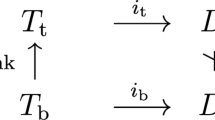Abstract
The emergence of macroscopic variables can be effected through coarse graining. Despite practical and fundamental benefits conveyed by this partitioning of state space, the apparently subjective nature of the selection of coarse grains has been considered problematic. We provide objective selection methods, deriving from the existence of relatively slow dynamical time scales. Using a framework for nonequilibrium statistical mechanics developed by us, we show the emergence of both spatial variables and order parameters. Although significant objective criteria are introduced in the coarse graining, we do not provide a unique prescription. Most significantly, the grains, and by implication entropy, are only defined modulo a characteristic time scale of observation.
Similar content being viewed by others
REFERENCES
M. Kac, Probability and Related Topics in Physical Sciences, Proceedings of the Summer Seminar, Boulder, Colorado, 1957, with special lectures by G. E. Uhlenbeck, A. R. Hibbs and B. van der Pol (Interscience, London, 1959).
For additional objections to coarse graining, see M. C. Mackey, “Microscopic dynamics and the second law of thermodynamics,” in Proceedings of the Conference, “Time's Arrows, Quantum Measurements and Superluminal Behavior,” Naples, Italy, October 2000, D. Mugnai, A. Ranfagni, and L. S. Schulman, eds. (Italian National Research Council (CNR)). See also M. C. Mackey, Time's Arrow: The Origins of Thermodynamic Behavior (Springer, New York, 1992).
H. D. Zeh, The Physical Basis of The Direction of Time, 3rd edn. (Springer, New York, 1999).
J. B. Hartle, “Spacetime coarse grainings in nonrelativistic quantum mechanics,” Phys. Rev. D 44, 3173 (1991).
J. J. Halliwell, “The emergence of hydrodynamic equations from quantum theory: A decoherent histories analysis,” Found. Phys. Lett. 39, 1767 (2000).
L. S. Schulman, Causality is an effect, in Proceedings of the Conference, “Time's Arrows, Quantum Measurements and Superluminal Behavior,” Naples, Italy, October 2000, D. Mugnai, A. Ranfagni and L. S. Schulman, eds. (Italian National Research Council (CNR)).
B. Gaveau and L. S. Schulman, “Master equation formulation of non-equilibrium statistical mechanics,” J. Math. Phys. 37, 3897 (1996).
B. Gaveau and L. S. Schulman, “A general framework for non-equilibrium phenomena: The master equation and its formal consequences,” Phys. Lett. A 229, 347 (1997).
B. Gaveau and L. S. Schulman, “Theory of non-equilibrium first order phase transitions for stochastic dynamics,” J. Math. Phys. 39, 1517 (1998).
B. Gaveau, A. Lesne, and L. S. Schulman, “Spectral signatures of hierarchical relaxation,” Phys. Lett. A 258, 222 (1999).
L. D. Landau and E. M. Lifshitz, Statistical Physics, 3rd edn., Part 1, pp. 13–14 (1980). Translated by J. B. Sykes and M. J. Kearsley, Course of Theoretical Physics, Vol. 5 (Pergamon, Oxford, 1980).
A. Friedman, Foundations of Modern Analysis (Dover, New York, 1982).
L. J. Schulman, “Clustering for edge-cost minimization,” in Proceedings of the 32nd STOC (2000).
I. S. Gradshteyn and I. M. Ryzhik, Table of Integrals, Series, and Products, 4th edn. (Academic, New York, 1980).
L. S. Schulman, Time's Arrows and Quantum Measurement (Cambridge University Press, Cambridge, 1997).
One can carry this perspective to its logical extreme, perhaps leading to a physics analog of the remark of L. Mies van der Rohe, “God is in the details” New York Herald Tribune, 28 June 1959).
Author information
Authors and Affiliations
Rights and permissions
About this article
Cite this article
Schulman, L.S., Gaveau, B. Coarse Grains: The Emergence of Space and Order. Foundations of Physics 31, 713–731 (2001). https://doi.org/10.1023/A:1017577211902
Issue Date:
DOI: https://doi.org/10.1023/A:1017577211902




